Learn more about Gardening with Native Plants.
Holiday Closures
In observance of the Christmas and New Year’s holidays, the City of Boulder is adjusting its operations schedules.

Learn more about Gardening with Native Plants.
| Common Name | Latin Name (Weber) | Height (Feet) | Preferred Environment | Comments and Tips |
|---|---|---|---|---|
Aster, Golden 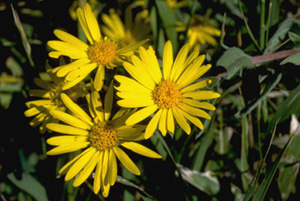
| Heterotheca villosa | 1-2 | Dry | An easy-to-grow aster of early summer with a flat, spreading habit. Leaves are hairy gray-green. Starts from seed and transplants easily when it is still small. Perennial. A nice addition to borders and edges. |
Aster, Porter's 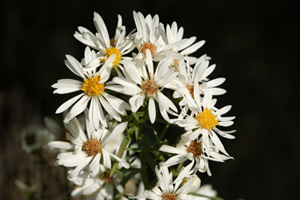
| Aster porteri | 1-2 | Dry | Unique to the Front Range! A hardy aster with a profusion of small white flowers, Porter's asters remain green nearly all winter with long thin leaves. They work very well in rock gardens, where they remain smallish until all the other spring flowers are done. By late summer they have become rounded mounds of flowers. Very hardy and easy to transplant. Will start easily from seed. Perennial. |
Aster, Smooth 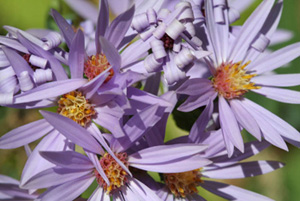
| Aster laevis | 2-3 | Dry | A lovely tall blue-purple aster of late summer, smooth asters start readily from seed and will bloom during their first year. They transplant easily, but need care and water after a move. Once established, they may spread aggressively but can be easily pulled. Deer will browse the foliage, but this seems to help the plants bush out and become less tall and spindly when they bloom. |
Aster, White Prairie (Heath Aster) 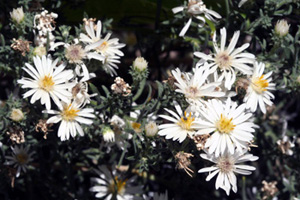
| Aster falcatus (Virgulus falcatus) | 1-2 | Full sun, dry | A very hardy and showy aster of the plains. It will grow in the hottest and driest conditions and never need water. Transplants easily. Blooms from late summer well into fall. It will reseed itself and grow by underground runners, which can be broken off and replanted to help it spread. |
Beebalm (Horsemint, Wild Bergamot) 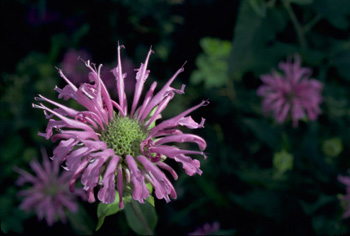
| Monarda fistulosa | 1 - 2 | Part sun, Dry/Moist | Large showy flowers and oregano-scented foliage distinguish this member of the mint family. It starts easily from seed and transplants easily too. The huge flowers attract scores of bees and butterflies. Nurseries may stock some non-native Monardas. |
Blue-eyed Grass 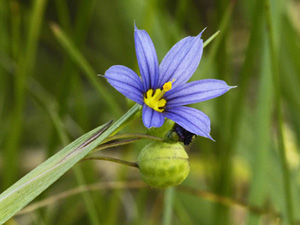
| Sisyrinchium montanum | .5 - 1 | Part sun, Dry/Moist | Not a grass at all, but a native member of the iris family. Plants grow in grass-like clumps and produce many small but very attractive blue flowers. Hardy, transplants easily, and locally available at nurseries. Will tolerate dry conditions. Perennial. Place it along edges and borders, where taller plants won't cover it. |
Black-eyed Susan 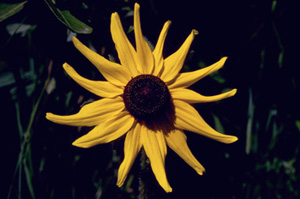
| Rudbeckia hirta | 1 - 2.5 | Part sun, Dry/Moist | Hardy. Frequent in dry mountain meadows. Available from many nurseries but try to avoid cultivars if possible. Perennial. |
Blanket Flower, Gaillardia 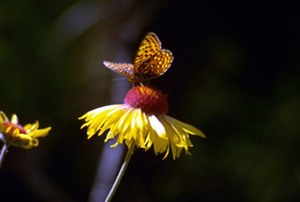
| Gaillardia aristata | 1 - 2 | Sun, Dry | Hardy, but may become delicate for a while after transplanting. Verify source of commercial varieties, many are hybrids; the native "wild type" has petals of a pure golden-yellow (no red). Butterflies are fond of these flowers. Perennial. The flowers are a host to the lovely Gaillardia Moth which is colored exactly like the flower. |
Native Blue Flax 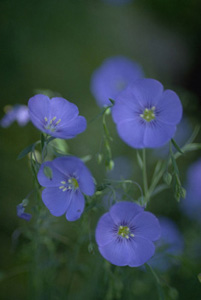
| Adenolinum (Linum) lewisii | .5 - 1 | Sun, Dry | Watch out for the non-native European flax, which has a similar appearance. The native is generally smaller, and its stems flop open loosely near the ground; the European flax is often taller with more erect stems that flare out at the top, giving the plant a vase-like shape. |
Bush Sunflower 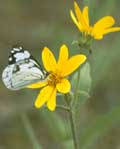
| Helianthus pumilus | 8" - 2.5 | Sun, Dry | Butterflies love the flowers, and birds love the seeds as a winter treat. Deer may browse. Annual. Many nurseries carry non-native sunflowers and cultivars. Shop carefully. |
Curly-cup Gumweed 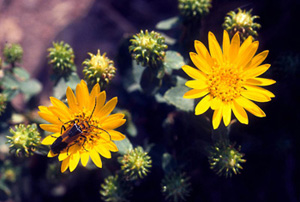
| Grindelia squarrosa | 1-2 | Sun, Dry | A weedy-looking biennial that produces scores of beautiful golden aster-like flowers. Once established, it is hardy and spreads prolifically from seed. The flower cups have small curly protrubances that secrete a strongly-smelling gum. Can be transplanted with care during its first year (rosette phase) but should not be moved its second year, when it bolts, blooms and produces seeds. Flowers from mid-summer through fall. |
Cut-leaf Fleabane 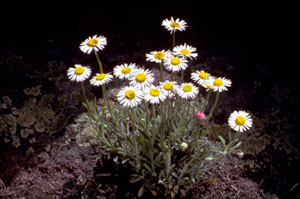
| Erigeron compositus | 1 | Dry | A hardy little white aster with finely divided leaves, it forms rounded mounds of foliage and early spring flowers that tuck nicely into crevices in rock gardens. Available at nurseries. Perennial. |
Evening Primrose, Yellow 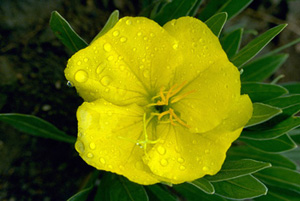
| Oenothera howardii (brachycarpa) | 0.5 | Full Sun, Dry | Perennial, blooms in early evening, common along Front Range. The blossoms attract moths and produce a sweet fragrance. It will grow happily in the hottest, driest locations and never need water once established. Some non-native evening primroses are sold at nurseries. Check those scientific names! |
Evening Primrose, White 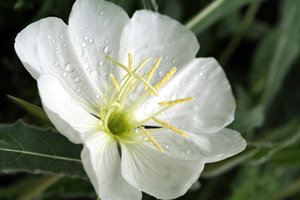
| Oenothera caespitosa | 0.5 | Full Sun, Dry | This perennial blooms in early evening. The huge, soft white flowers produce a delicious aroma and attract moths. The leaves are a food plant for white lined sphinx moths (look for the green hornworm caterpillars in June). It will grow happily in the hottest, driest locations and never need water once established. Transplants fairly easily but may require water and TLC after a move. Deer will browse it. Available in local nurseries. |
Fireweed 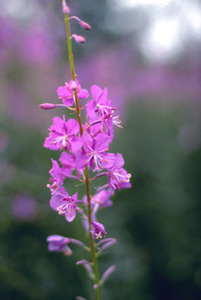
| Epilobium angustifolium, Chamerion angustifolium | up to 6' | Partial shade, Dry to Moist | Hardy and forming patches, fireweed has show-stopping pink or fuchsia red flowers. It does well in shady areas where nothing else seems to grow. Its name comes from its tendency to appear in disturbed areas following forest fires. Deer may browse the foliage and flowers. |
Dotted Gayfeather (Blazing Star) 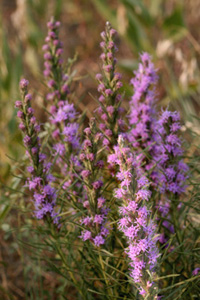
| Liatris punctata | .5 - 2 | Sun, Dry | Perennial, starts easily from seed (a seedling takes several years to mature and bloom.) The plant appears late in spring and grows unobtrusively throughout the summer, then puts forth a spectacular stalk of lavender flowers in late summer. Very hardy and drought tolerant. Non-native Liatris are available at local nurseries; check scientific names! |
Wild Geranium 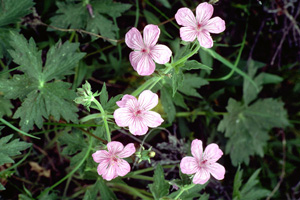
| Geranium caespitosum | 1 - 2 | Part sun, Moist | A perennial that starts easily from seeds and may develop a rounded growth habit that fills in rock gardens. Difficult to transplant adult plants, but it can be moved when still a small seedling. Deer may browse. |
Golden Banner 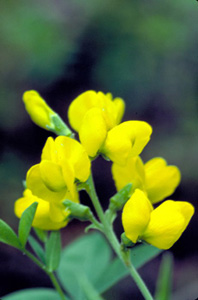
| Thermopsis divaricarpa | 1 - 2 | Part or full sun, Dry to Moist | This perennial starts easily from seeds, which may germinate better if they have been scratched and soaked. Young plants may not bloom for several years but are worth the wait. Because of its deep and delicate root system, it is very difficult to transplant except as a seedling. It spreads via seeds (look for the tiny pea-like pods) and through underground roots of rhizomes. It may become aggressive. |
Goldenrod species 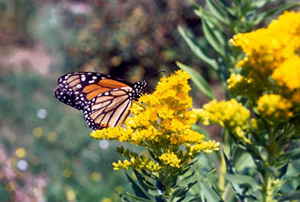
| Solidago spp. | Variable | Sun, Dry/Moist | Many and varied species. Once established, goldenrods are hardy and aggressive (they may spread by seeds and underground roots) but require much watering and care after they have been moved. Their flowers make beautiful dry arrangements. Perennial. Contrary to popular belief, goldenrods do not cause allergies. |
Harebells 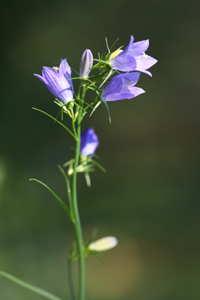
| Campanula rotundifolia | .5 - 1 | Part sun, Moist | This lovely perennial plant is a wonderful addition to rock gardens: it spreads to fill around the stones. Scores of flowers appear in June and last into the fall. When small, its leaves are roundish but become long and thin as the plant matures. Trivia: Also known as Bluebells of Scotland, this plant is circumpolar in distribution. It is often sold in nurseries. Avoid at all costs: the non-native relative Creeping Bellflower (Campanula rapunculoides)! Although similar in looks, this aggressive plant will take over your garden and prove very hard to get rid of. |
Leafy Cinquefoil 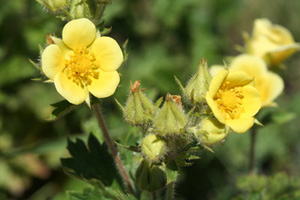
| Drymocallis fissa | 1 | Dry | A small leafy plant with pale green leaves and smallish yellow flowers, it is well behaved and fits nicely into crevices in rock gardens. Deer may browse it. Perennial. |
Mouse-ear Chickweed 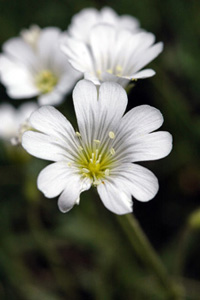
| Cerastium arvense ssp. strictum | .5 | Dry | Small white flowers appear in spring. As the plant spreads from year to year, it takes on the appearance of a carpet of little white blooms. Transplant hardy perennial. Watch out for Cerastium tomentosa, a non-native commonly stocked by nurseries in the xeriscape section. The non-native's leaves are larger, hairy and have a blue green color. |
Pasque Flower 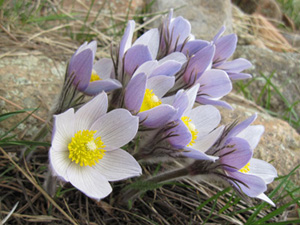
| Pulsatilla patens | Part sun, Dry/Moist |
Dry shade, dry partial sun | Huge, delicate purple flowers distinguish the Pasque flower, which blooms around Easter. Often found under ponderosa pines. Perennial. Most nurseries carry the European Pasque flower so ask carefully. |
Penstemon, Blue Mist (Low Penstemon) 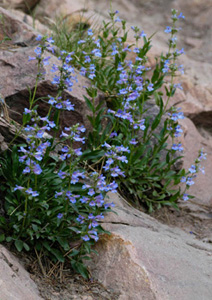
| Penstemon virens | .5 - 1 | Part sun, Dry | Forms dense clumps and may produce many volunteer seedlings. This perennial is available by seed and in Boulder area nurseries. Transplants easily. Perennial. Plant it along boders and edges so it is not overwhelmed by larger plants. Many non-native penstemons are sold at nurseries. Check those scientific names! |
Penstemon, One-sided 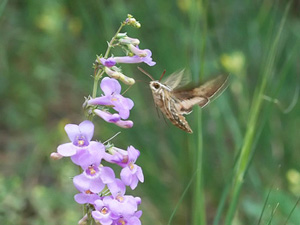
| Penstemon secundiflorus | .5 - 1.5 | Part sun, Dry | A mid-sized penstemon with attractive light blue-green leaves and stunning stalks of lavender flowers. It starts easily from seed and transplants easily too. It attracts honey bees and occasionally hummingbirds. Available in some Boulder-area nurseries. Deer may browse off the flower stalks. Perennial. Many non-native penstemons are sold at nurseries. Check those scientific names! |
Penstemon, Rocky Mountain 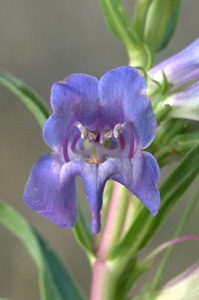
| Penstemon strictus | 1 - 2 | Part sun, Dry/Moist | This penstemon is common west of Continental Divide. When planted in clumps, it produces show-stopping clusters of tall indigo and lavender flowers, much loved by insects. Transplant hardy. Perennial. Many non-native penstemons are sold at nurseries. Check those scientific names! |
Penstemon, Tall 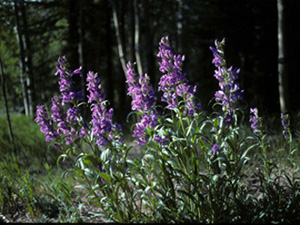
| Penstemon virgatus | 2 | Part sun, Dry/Moist | Flowers numerous. Perennial. Many non-native penstemons are sold at nurseries. Check those scientific names! |
Prairie Cone Flower (Mexican Hat) 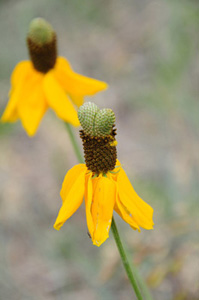
| Ratibida columnifera | 1 - 2.5 | Sun, Dry | This perennial blooms from June into the fall. It is hardy and easily reseeds itself. Flowers come in both yellowish and reddish morphs. Requires much watering and care when transplanted. Purple coneflowers, often sold at local nurseries, are not actually native to Colorado but occur naturally on eastern prairies and need supplemental water. |
Prairie Smoke 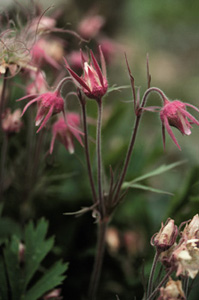
| Geum trifolium | .5 | Dry | Delicate reddish blooms in spring give way to fluffy smoke-like seeds in summer. Available in nurseries, but watch out for non-native Geums. Perennial, deer may browse it. |
Twistspine Pricklypear Cactus 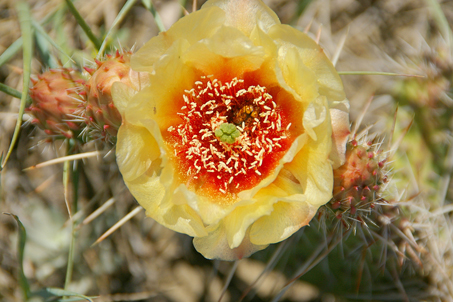
| Opuntia macrorhiza (compressa) | 4 - 8" | Sun, Dry | Sparse spines, perennial. |
Plains Pricklypear Cactus 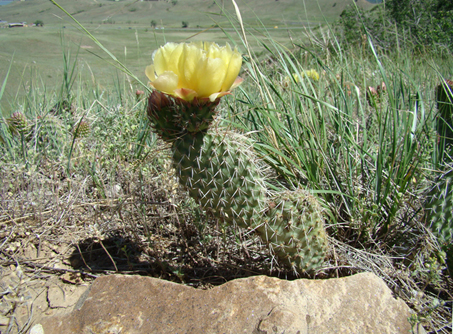
| Opuntia polyacantha | 4 - 8" | Sun, Dry | Very spiny, with both large spines and very fine, hairlike spines. It is a lovely, hardy addition to a garden, but a hazard to be aware of while weeding. The huge yellow flowers appear in June, followed by reddish fruits in the fall. Transplant hardy. |
Pussytoes 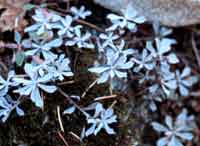
| Antennaria parvifolia | 2 - 6" | Dry | Perennial, forms large low-growing mats with delicate gray-greenish foliage. We have seen it at some Boulder-area nurseries. Transplant hardy. |
Rocky Mountain Columbine 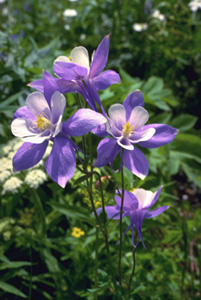
| Aquilegia caerulea | 1.5 - 2 | Sun/shade, Moist | The only native columbine in the Boulder area. Red, yellow and cultivar columbines are not native to Boulder. Will hybridize readily with any non-native columbines planted nearby. Available from many local nurseries. Deer may occasionally browse on it. Perennial. |
Rocky Mountain Bee Plant 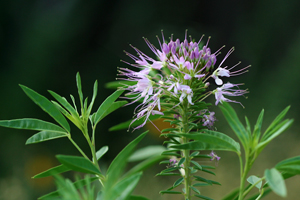
| Cleome serrulata | 1 - 3 | Sun, Dry | Abundant, midsummer along roadsides |
Blue Flag Wild Iris 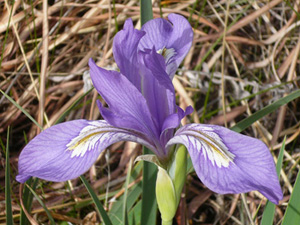
| Iris missouriensis | .5 - 1 | Part sun, moist | Wild irises are more delicate and require more moisture than their non-native tall bearded counterparts. They are well worth the extra trouble! They often do well under downspouts where they receive a lot of sun. After they bloom, they are very hardy to drying out. Perennial. |
Sage, Prairie 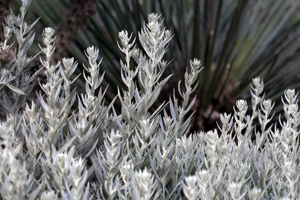
| Artemisia ludoviciana | 1 - 2.5 | Dry | A lovely perennial with fragrant silvery-white greenish foliage. It establishes easily and spreads aggressively, but may be controlled simply by uprooting periodically. Transplants from root stocks. Trivia: scientific name for Merriweather Lewis of Lewis and Clark. |
Sage, Silver (Fringed Sage) 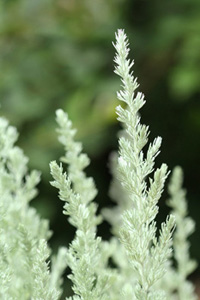
| Artemisia frigida | 4 - 8" | Dry | This lovely foliage plant is gorgeous in rock gardens. It is very transplant hardy and will start from fragments of root stock. It is a woody perennial with fragrant, silver-gray foliage. Available at local nurseries. |
Scarlet Globemallow (Cowboy's Delight) 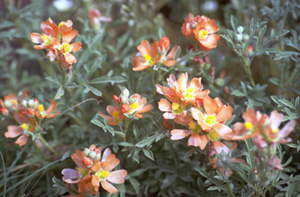
| Sphaeralcea coccinea | .5 - 1 | Sun, Dry | Perennial with a deep tap root, this native prairie plant is very drought tolerant. Clusters of reddish-orange flowers appear in June. Very transplant hardy, but will often appear to die after you move it. Don't be fooled - it will come back next year. |
Showy Milkweed 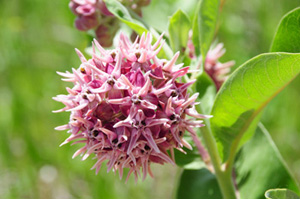
| Asclepias speciosa | 1.5 - 5 | Sun, Moist | Common on roadsides, fields and along ditches. Milkweed starts very easily from seed and transplants easily when small. The flowers attract a remarkable assortment of butterflies, moths and other insects and the leaves are the foodplant for Monarch butterflies. It may require several seasons to reach mature blooming size. |
Shooting Star 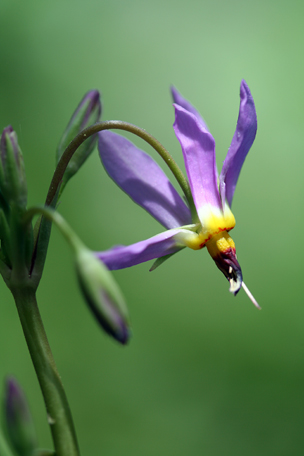
| Dodecatheon pulchellum | .5 | Shade, Moist | Shooting stars produce small, delicate pink flowers in late May to early June. Once the blooms are finished, the leaves wither away until next spring. NOT XERISCAPE! - This plant needs very moist conditions which simulate its home along creeks and in wet, shady canyons. Perennial. We have seen it occasionally in Boulder area nurseries. |
Silvery Lupine 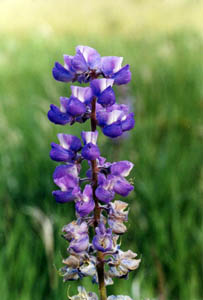
| Lupinus argenteus | 1 - 2.5 | Sun, Dry/Moist | Lupines start easily from seeds, especially if they are scratched and soaked. Young plants may not bloom for several years but are worth the wait. Seedlings seem to survive better if they are not transplanted until their second year - many transplanted youngsters die during the heat of July. Be sure to get the entire deep root when you move them! Nearly all lupines for sale at nurseries are non-natives! Check scientific names. |
Blue Spiderwort 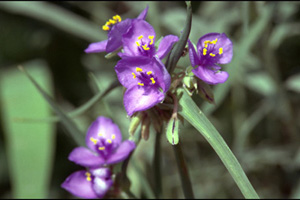
| Tradescantia occidentalis | .5 - 2 | Sun, Dry/Moist | Perennial with deep purple or lavender three-petaled flowers. This prairie native transplants easily. Deer may browse it. |
Sulfur Flower 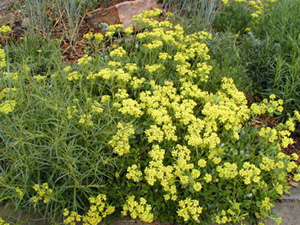
| Eriogonum umbellatum | 4" - 1 | Sun, Dry | A hardy rock garden plant which fills in around stones and boulders. Balls of yellow flowers appear in June. Deer may browse occasionally. Perennial. |
Sweet Cicely 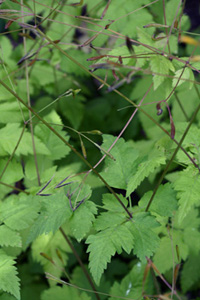
| Osmorhiza depauperata | 1 - 2 | Dry or moist / Shade | An attractive foliage plant with delicate, wispy leaves that thrives in dry shade. In late spring, tiny white flowers give way to clusters of long, thin seeds. The leaves and seeds have an odor of anise when crushed. The plant may become a little aggressive, and re-seeds itself, requiring some attention to keep it from taking over its corner of the yard.
|
Western Wallflower 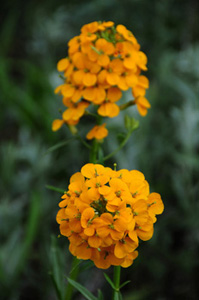
| Erysimum asperum | .5 - 2 | Sun, Dry | A biennial that flowers in late spring to early summer. Deer may browse off the flower stalks. |
Yarrow (White or Wooly Yarrow) 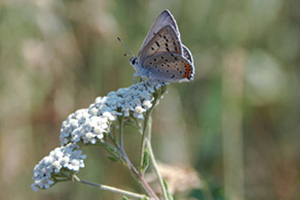
| Achillea lanulosa | .5 - 2 | Part sun, Dry/Moist | This very hardy perennial spreads by seed and underground roots (rhizomes). It is often found in disturbed areas. It is very transplant hardy and attracts butterflies. Watch out for colored non-native cultivars in yellow, red and pink. |
|
Common Name |
Latin Name (Weber) |
Height (Feet) |
Preferred Environment |
Comments |
|---|---|---|---|---|
|
Antelope Bitterbrush 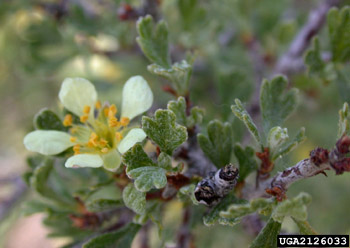
|
Purshia tridentata |
5 |
South-facing slopes, dry well-drained soils |
Attractive, birds eat seeds |
|
Boulder Raspberry 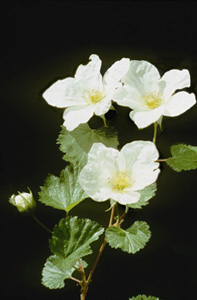
|
Oreobatus (Rubus) deliciosus |
5 |
Dry but prefers moist / Partial shade |
Very attractive huge white flowers; wildlife will eat the fruits which aren't very tasty to people. |
|
Buckbrush 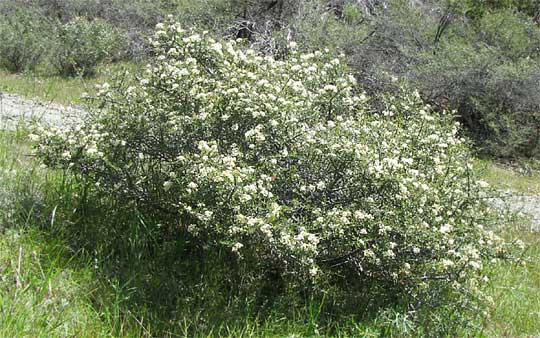
|
Ceanothus fendleri |
2 |
Dry / Sun to partial shade |
Spiny |
|
Common (or Low) Juniper 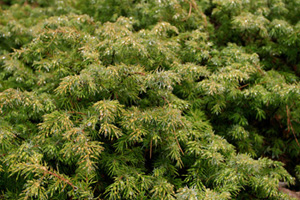
|
Juniperus communis ssp. alpina |
3 |
Dry or moist / Shade |
Attractive, broad evergreen shrub that grows low to the ground. Requires shade and moisture. |
|
Dwarf False Indigo or Dwarf Leadplant 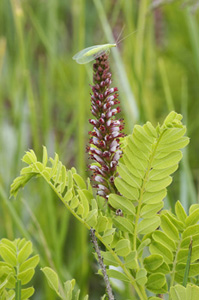
|
Amorpha nana |
3 |
Dry / Sun |
A small native shrub which is listed as a state species of special concern. Leaves are late to appear in spring; the purple flower stalks produce a very sweet, fragrant aroma. |
|
Four-winged Saltbush 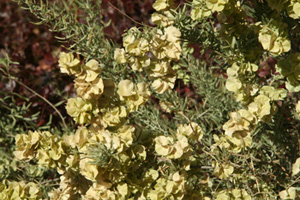
|
Atriplex canescens |
5 |
Very Dry / Sun |
Seeds eaten by birds. |
|
Golden Currant 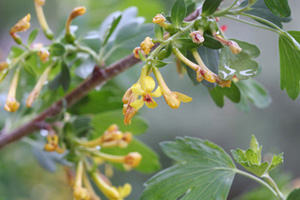
|
Ribes aureum |
6 |
Dry to moist / Partial shade |
This bush greens up quickly in spring and produces scores of delicate golden-yellow flowers. The flowers sometimes have a clove scent. In late summer, small greenish-golden fruits feed wildlife. Deer will browse foliage. Readily available at nurseries. |
|
Kinnikinnick or Bearberry 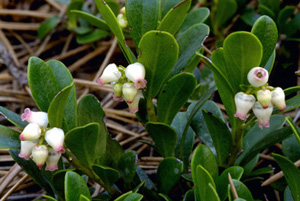
|
Arctostaphylos uva-ursi |
1 |
Semi-dry areas; needs acidic, well-drained soil/ Shade |
Attractive, waxy leaves and red berries; ground cover. Browsed by a wide variety of wildlife. Occasionally found at nurseries. |
|
Ninebark 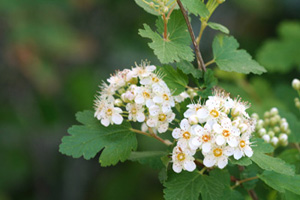
|
Physocarpus monogynus |
4 |
Dry to moist / Shade |
Very attractive, showy flowers; birds eat seeds |
|
Ocean Spray 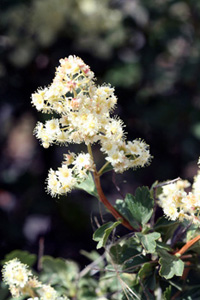
|
Holodiscus dumosus |
10 |
Dry but prefers moisture / Sun or partial shade |
A lovely drought-tolerant shrub that produces spires of creamy white flowers in late spring or early summer. Often available in nurseries. |
|
Creeping Mahonia or Oregon Holly Grape 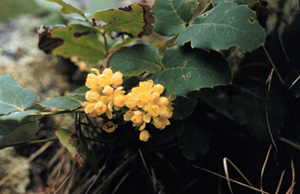
|
Mahonia repens |
1 |
Dry / Sun but prefers shade |
Holly-like leaves; attractive ground cover or small shrub. Yellow sweet-scented flowers appear very early in spring; birds eat the sour grape-like fruits. Will grow from seed, transplants easily and may be started from root stocks. Plants take several years to mature and bloom.
Several much taller non native Mahonias are commonly sold in local nurseries - Mahonia aquifolium (tall grape holly) and M. bealii (leatherleaf mahonia). Be sure to ask for M. repens.
|
|
Rabbitbrush or Chamisa 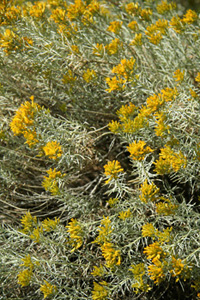
|
Chrysothamnus nauseosus |
1-6 |
Hot Dry /Sun |
A very attractive drought tolerant shrub which produces masses of greenish-gray foliage. It will grow in the driest, hottest part of your yard. Yellow flowers in late summer attract clouds of butterflies. If the plant becomes straggly or overgrown, give it a severe haircut. You will be amazed how quickly it recovers and fills out! |
|
Dwarf Blue Rabbitbrush 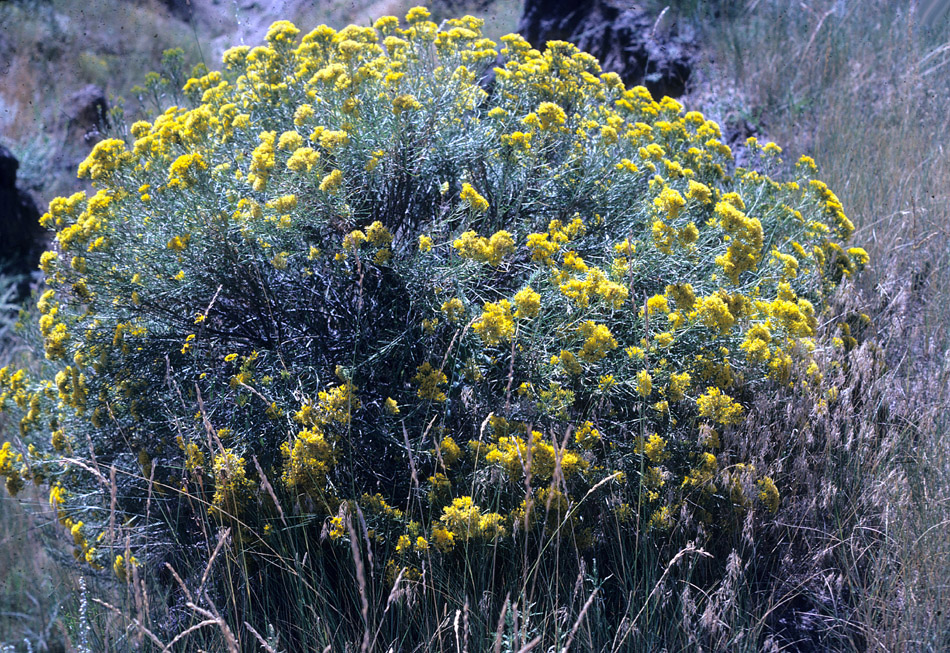
|
Chrysothamnus nauseosus ssp. nauseosus |
1-4 |
Hot Dry / Sun |
A smaller local variety of the Rabbitbrush listed above. 1-4 feet tall at maturity |
|
Shrubby Cinquefoil 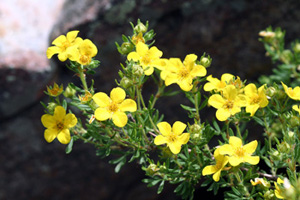
|
Pentaphylloides floribunda (Potentilla fruticosa) |
3 |
Dry / Sun or partial shade |
Often cultivated as an ornamental; attractive. Many cultivars are available at nurseries. |
|
Snowberry 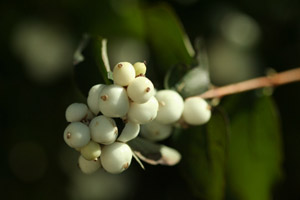
|
Symphoricarpos albus |
3 |
Dry / Shade |
Attractive red stems and white fleshy berries. This plant grows and transplants easily and needs no care, it will thrive in shady dry places where nothing else seems to grow. |
|
Virginia Creeper 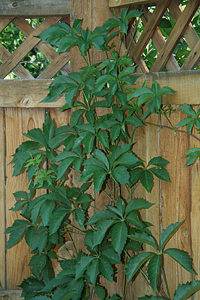
|
Parthenocissus quinquefolia |
20 - 30 |
Part sun, Dry / Moist |
A very hardy climbing vine that adheres to walls and fences with small sticky pads. The tiny pale green flowers become dark purple berries that are food for birds but mildly toxic to humans. In fall, the foliage turns a spectacular crimson. It may cover and shade out other plants if not pruned occasionally. Virginia creeper is used to shade and cool buildings in summer - the sticky pads do not penetrate masonary, but adhere to the surface. Trying to rip the plant from a wall may damage the surface; but if the plant is first killed, by severing the vine from the root, the adhesive pads will eventually deteriorate and release their grip. |
|
Wax Currant 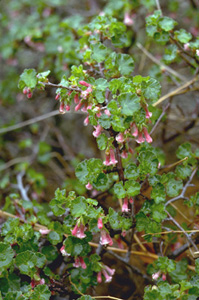
|
Ribes cereum |
4 |
Dry / Partial shade |
Not spiny; wildlife eat the fruits, which are related to gooseberries. |
|
Cliffrose or Waxflower 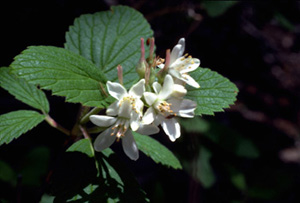
|
Jamesia americana |
6 |
Sun / dry |
Because it naturally grows on cliffs, it makes a fine medium-sized shrub for rock gardens. Aromatic, with attractive white flowers in spring. |
|
Western Virgin's Bower 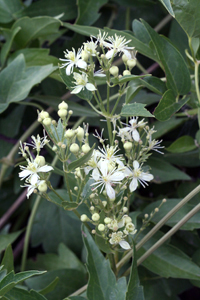
|
Clematis ligusticifolia |
creeping vine |
Sun or shade / Dry |
A very hardy climbing vine for dry areas, tolerates clay soils. In late summer vines produce clusters of small, delicate white flowers. Female plants then produce masses of feathery seeds. Starts from seed and transplants fairly easily. Can be trained to climb a trellis. |
|
Wild Grape 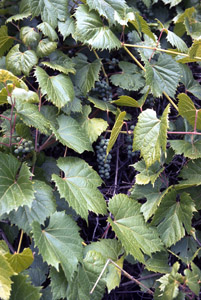
|
Vitis riparia |
creeping vine |
Part sun, Dry / Moist |
A hardy but slow-growing climbing vine that produces fruit for wildlife. Starts easily from seed and can be trained up a trellis to form a shaded arbor. Grape leaves are host plants for several attractive local moths. |
|
Wood's Wild Rose 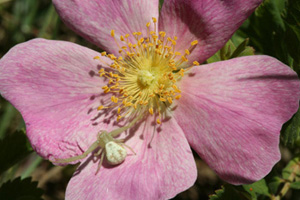
|
Rosa woodsii |
1-6 |
Dry / Sun but prefers moist partial shade |
Wildlife feed on the red rose hips, which are an excellent source of Vitamin C. Some find it aggressive in gardens. Stems are often covered with small sharp thorns, more an annoyance than a hazard. |
|
Winterfat 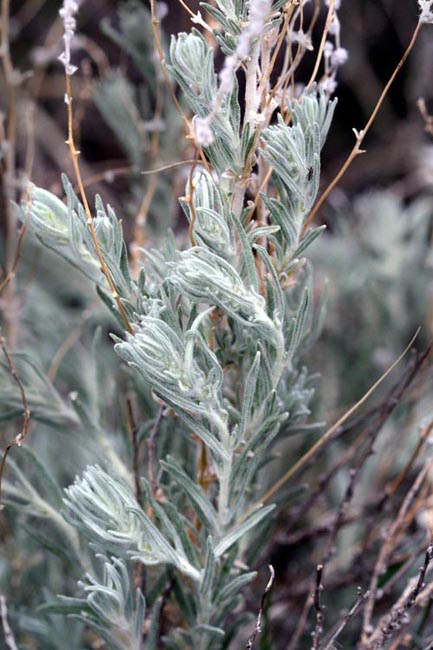
|
Kraschenin-nikovia (Ceratoides) lanata |
1-3 |
Dry / Sun, Sandy alkaline soils |
Flower clusters become fluffy resembling lambs' tails. |
|
Plains Yucca 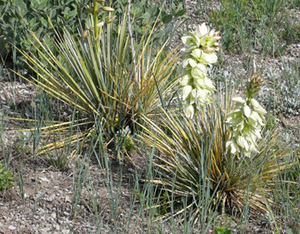
|
Yucca glauca |
3 |
Hot Dry / Sun |
A very hardy, drought tolerant prairie plant that starts easily from seed and transplants easily when small. The seedlings seem to require shade and moisture for the first few years. Its sharp foliage may injure a careless gardener. The spectacular stalks of white flowers won't appear until the plant is several years old. Yuccas will grow best in the hottest driest parts of your yard. |
|
|
||||
|
Boxelder 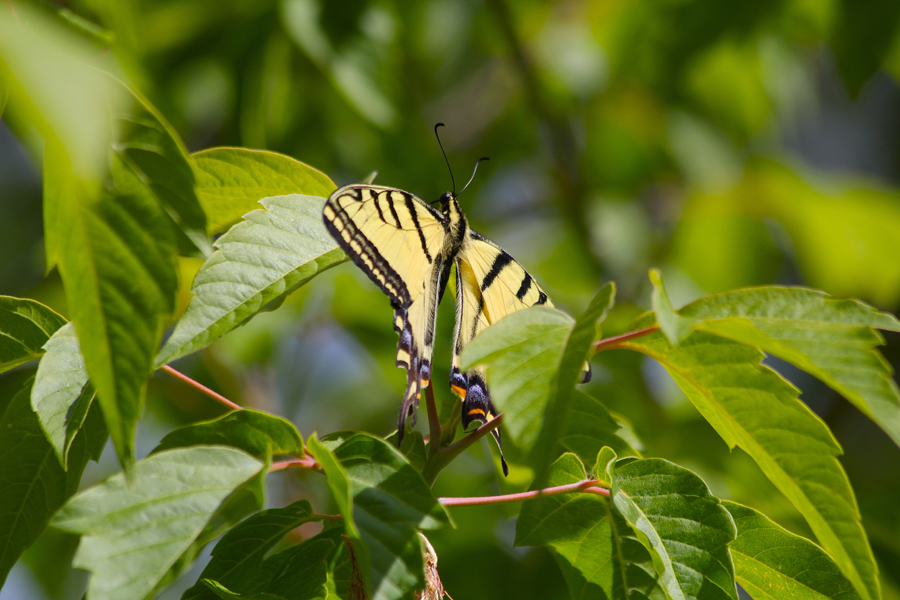
|
Negundo aceroides (Acer negundo) |
20 |
Stream banks |
Leaves yellow in fall |
|
Chokecherry 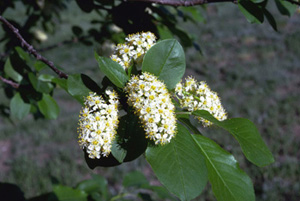
|
Padus (Prunus) virginiana ssp. melanocarpa |
12 |
Dry / Sun but prefers moist partial shade |
In spring, this bush displays sprays of tiny white scented flowers that attract bees and butterflies. The sour astringent purple fruits are a favorite of wildlife and can be boiled down to make fine pancake syrup and jam (with sugar added!). Chokecherries may spread aggressively underground through suckers and may require space and pruning. Deer may browse the foliage. Chokecherries will sprout readily from seeds but take several years to reach maturity. Transplant easily. |
|
Western Hackberry 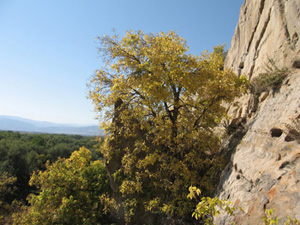
|
Celtis reticulata |
12 |
Dry rocky hillsides and ravine banks |
A small tree of the plains. Small reddish-brown fruits eaten by birds. The leaves turn golden-yellow in fall. |
|
Hawthorn 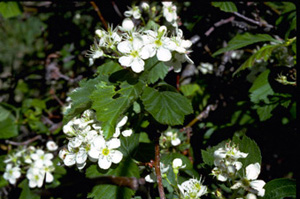
|
Crataegus erythropoda |
10 |
Dry / Sun |
Beautiful white flowers in spring, like miniature white roses. Fruits are berries like rose hips, red and woody, but are eaten by some animals. Beware the thorns, up to 2" long, shiny red. Thornless variety may be available in the nursery trade. |
|
Native Mountain Ash 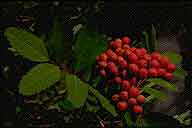
|
Sorbus scopulina |
12 |
Rocky canyons and ravines |
Orange berries produced in fall are said to appeal to wildlife, although this doesn't seem to be the case in Boulder. Deer may aggressively browse the leaves. Most nurseries stock the European mountain ash, Sorbus aucuparia. Check the name carefully! |
|
Mountain Mahogany 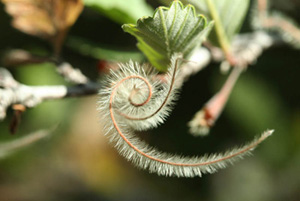
|
Cercocarpus montanus |
15 |
Open rocky woods and stony soils |
A drought-tolerant attractive shrub. Seeds have long furry "mouse tails" attached. Leaves turn yellowish in fall, but the plant is sometimes evergreen. Deer may browse the leaves. Often available in nurseries. |
|
Rocky Mountain Juniper 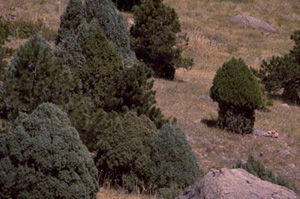
|
Sabina (Juniperus) scopulorum |
15-40 |
Dry / Sun |
A hardy drought-tolerant tree that can thrive in full hot sun. Birds eat the fruits. |
|
Rocky Mountain Maple 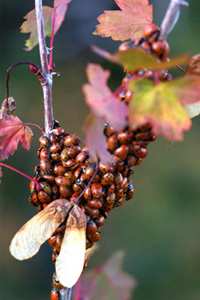
|
Acer glabrum |
15 |
Moist / Shade |
More of a large, loose bush than a tree. Attractive red stems. Birds eat seeds, buds, and flowers. Attractive fall colors. |
|
Serviceberry 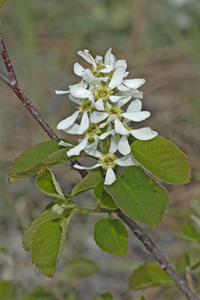
|
Amelanchier alnifolia |
15 |
Dry but prefers moist / Shade |
An attractive tall shrub which produces white flowers in spring. Fruits eaten by wildlife (and people!). Transplants easily. Varieties and cultivars are readily found in nurseries. Seedlings may volunteer. |
|
Silver Buffaloberry 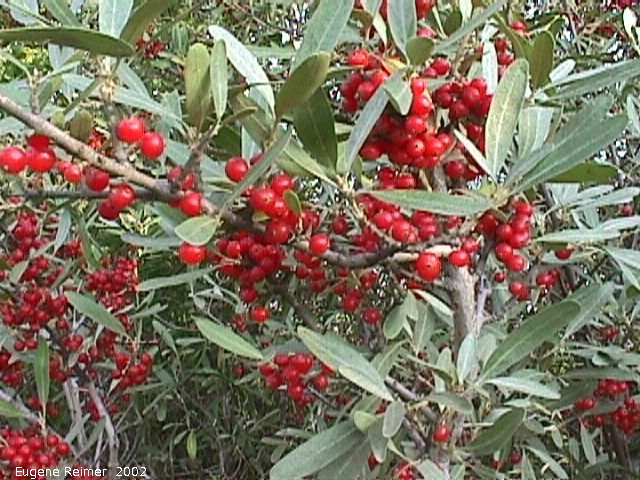
|
Shepherdia argentea |
12 |
Streamsides and river bottoms |
Leaves silvery on both sides; branches spiny. Native cousin of the noxious Russian Olive. |
|
Sumac, Smooth 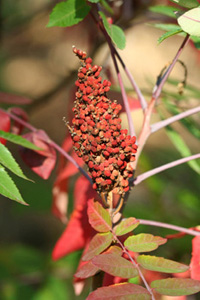
|
Rhus glabra |
5 |
Dry / Sun Slopes and canyonsides |
This is a medium sized shrub that grows in patches and clumps. Leaves appear late in spring and turn a spectacular crimson in autumn.
AVOID the similar but much larger and more aggressive staghorn sumac (R. typhina) - our native doesn't have velvety branches. |
|
Sumac, Three-leaf (Skunkbush) 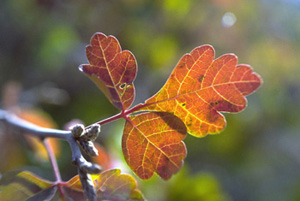
|
Rhus aromatica ssp. trilobata |
5 |
Dry / Sun |
Don't be put off by this shrub's name! It is a drought-tolerant gem. Wildlife eats the dry red-yellow fruits, which taste like dill pickles. Leaves appear late in spring but last into the fall, when they turn lovely shades of yellow, red and orange. Trivia: American Indians prepared a sour lemonade-like drink from the berries. Commonly available at nurseries. |
|
Thin-leaf Alder 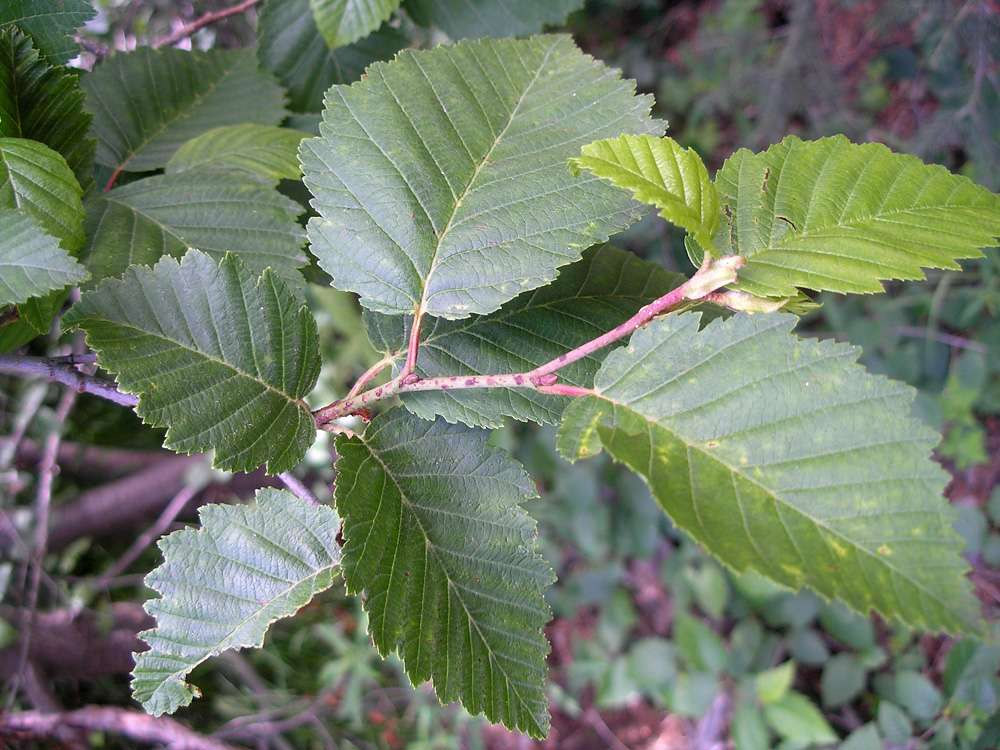
|
Alnus incana ssp. tenuifolia |
18 |
Swampy ground or sandy soil; montane stream banks and pond borders |
Female catkins are cone-like and persist through winter |
|
Wild Plum 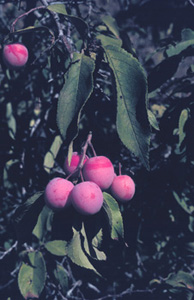
|
Prunus americana |
12 |
Dry or moist / Sun |
These shrubs produce aromatic displays of white flowers each spring. They often form thickets; 1" yellow to red fruits are edible. They will start from seed but take some years to reach maturity. They are somewhat delicate to transplant. |
|
|
||||
|
Lance-leaf Cottonwood 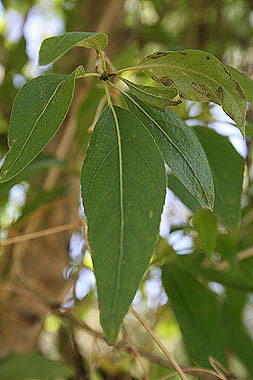
|
Populus x. acuminata |
40 - 60 |
Stream banks and valleys |
First generation sterile hybrid between P. deltoides and P. angustifolia; leaf-shape is indicative of this cross. |
|
Narrow-leaf Cottonwood 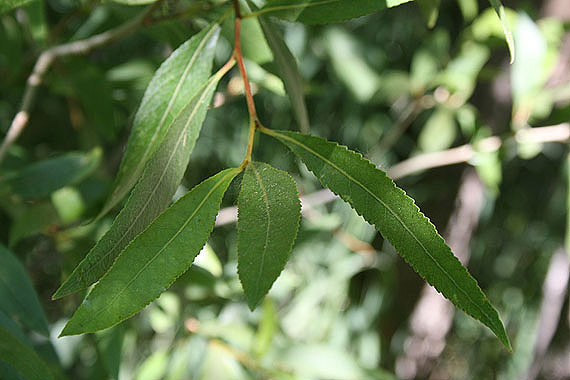
|
Populus angustifolia |
30 - 60 |
Stream banks and valleys |
Long narrow willow-like leaves turn yellow in fall. Available as a graft onto P. x acuminata rootstock which should reduce suckering. |
|
Plains Cottonwood 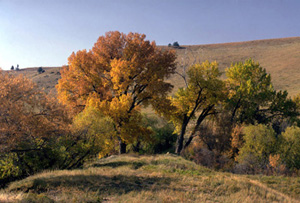
|
Populus deltoides ssp. monilifera |
60 - 80+ |
Moist soils; floodplains, riparian areas and valley bottoms |
Nursery stock should be male and therefore "cottonless"; broad leaves turn yellow-gold in fall. This tree will grow very quickly. |
|
Ponderosa Pine 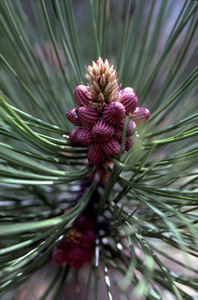
|
Pinus ponderosa |
60 - 80+ |
Variety of habitats - adaptable |
Tall evergreen tree grows to more than 80 feet, and can live for several hundred years. Seeds are eaten by birds and small mammals. It will grow well in dry, sunny locations. Be careful not to over-water it! |
|
Common Name |
Latin Name (Weber) |
Height (Feet) |
Preferred Environment |
Comments |
|---|---|---|---|---|
|
Big Bluestem 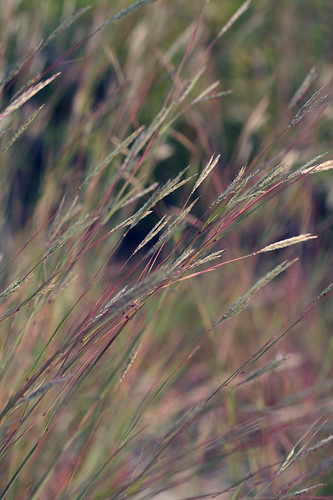
|
Andropogon gerardii | 3 - 7 | Moist/ sun | One of our showiest native grasses, Big Bluestem first appears in late spring and quickly develops through the summer and fall. In wet areas it could grow taller than you! Its distinctive three-lobed flower and seed head gives it the nickname "Turkey foot." As leaves and stems dry out at the end of the season, they may take on a reddish-purple hue. Available at local nurseries. Difficult to start from seed. Perennial. Prefers moist, sunny sites and may work well under downspouts. |
|
Blue Grama 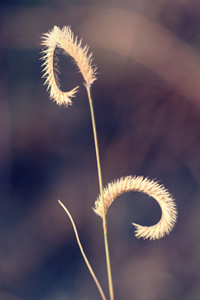
|
Chondrosum gracile (Bouteloua gracilis) | .5 - 1.5 | Dry/ Sun |
An excellent choice for a low water, low maintenance lawn (especially when combined with buffalo grass, see below). Starts easily from seed, which is best planted at the end of May and requires artificial watering until established. Seeds available locally. Trivia: This is the Colorado State grass. Note: It will not withstand as much foot traffic as a conventional bluegrass lawn. |
|
Buffalo Grass 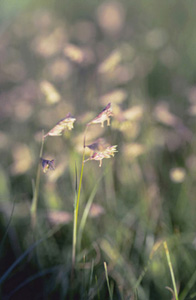
|
Buchloe dactyloides | 4 - 6" | Dry / Sun |
Prefers full sun, thrives in clay soils. An excellent choice for a low water, low maintenance lawn (especially when combined with blue grama grass, see above). Starts easily from seed, which is best planted at the end of May and requires artificial watering until established. Seeds available locally. Note: It will not withstand as much foot traffic as a conventional bluegrass lawn. |
|
Yellow Indian Grass 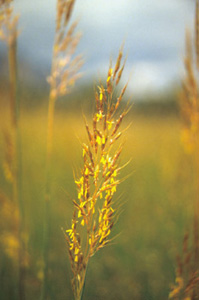
|
Sorghastrum avenaceum (nutans) | 3 - 8 | Moist/ Sun | A tall, showy perennial grass of prairies, bottomlands, open woods and meadows. Perennial. Prefers moist, sunny sites and may work well under downspouts. |
|
Little Bluestem 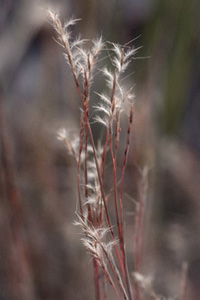
|
Schizachyrium scoparium | 1.5 - 5 | Dry/moist | Prairies, open woods, dry hills; Plants turn copper-red in fall. Starts easily from seed. Perennial. |
|
Mountain Muhly 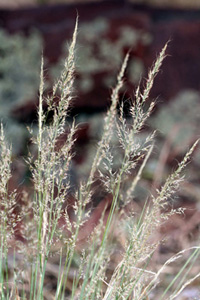
|
Muhlenbergia montana | .5 - 2 | Dry | Open woodlands, hillsides; May only be available by seed. |
|
Prairie Cordgrass 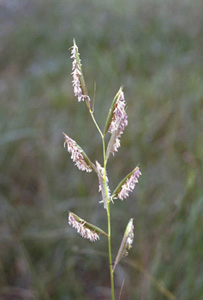
|
Spartina pectinata | 3 - 7 | Moist/ Sun | Marshes, wet meadows. Prefers moist, sunny sites and may work well under downspouts. Be careful - the margrins of the thick leaf blades are very rough and can scratch unprotected skin - hence its other name of "Ripgut." |
|
Sand Dropseed 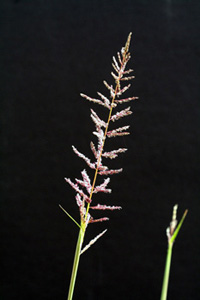
|
Sporobolus cryptandrus | 1 - 3 | Dry/ Sun or Shade | Sandy or loamsoils, sunny or shady dry areas. |
|
Side-oats Grama 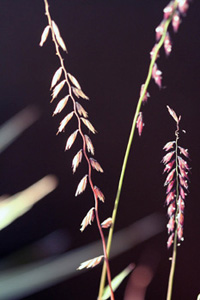
|
Bouteloua curtipendula | 1.5 - 2.5 | Dry/ Sun | Prairies, rocky hills. Very drought tolerant, starts easily from seed. Perennial. Thrives in full sun. |
|
Switchgrass 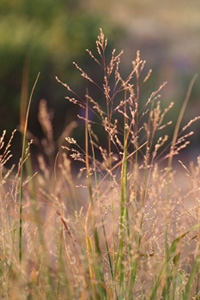
|
Panicum virgatum | 3 - 7 | Moist / Sun |
A tall, showy grass. Marshes, prairies, foothills. Prefers moist, sunny sites and may work well under downspouts. |
|
Western Wheat Grass 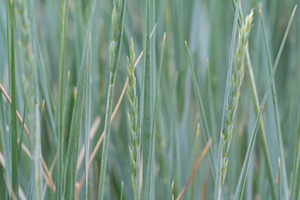
|
Pascopyrum (Agropyron) smithii | 1 - 2.5 | Dry-moist | Adaptable to variety of habitats. Very hardy and may become aggressive. Attractive blue-gray leaves are heavily veined. The tall flower and seed spikes appear in June. Perennial. |